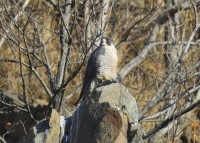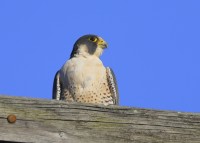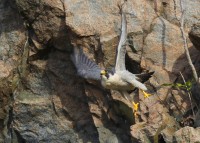Peregrine Falcon chicks: Week 4
June 16, 2024 in Peregrine Falcon Woburn
During the fourth week after hatching, peregrine falcon chicks (eyases) continue to undergo significant changes in preparation for fledging.
Day 22-24:
– Feather Development: By now, the chicks have a substantial amount of juvenile feathers, especially on their wings and back. The down feathers are mostly replaced by these juvenile feathers, which are darker and more streamlined.
– Weight and Size: The chicks continue to grow, with their weight reaching between 500-800 grams (18-28 ounces). Females are typically larger than males.
– Preening: Preening becomes more frequent as they take care of their feathers. This behavior helps ensure their feathers are in good condition for future flight.
Day 25-27:
– Wing Exercises: The chicks engage in vigorous wing flapping to strengthen their muscles. They may even start to lift slightly off the ground, practicing for their first flight.
– Mobility: Their movements become more coordinated and confident. They explore the nest area more thoroughly, hopping and walking around.
– Feeding: The parents continue to bring food, but the chicks may start to eat more independently. They can tear apart small pieces of meat on their own, though they still rely on their parents for larger prey.
Day 28:
– Social Interactions: Interactions with siblings become more complex and frequent. They engage in playful mock battles and other social behaviors that help them develop their hunting and survival skills.
– Vocalizations: The chicks’ vocalizations become more varied and sophisticated. They communicate more effectively with their parents and siblings.
– Independence: While still dependent on their parents for food, the chicks show increasing signs of independence. They may start to watch the sky more intently, observing their parents’ hunting and flying techniques.
Overall Development During the Fourth Week:
The fourth week is a crucial period for peregrine falcon chicks as they prepare for fledging. The significant growth in their feathers and the development of their muscles and coordination are essential for their first flight. The chicks’ increasing independence and social interactions also play a vital role in their preparation for life outside the nest. The parents continue to provide food and protection, but the chicks’ growing autonomy signals their readiness to leave the nest soon.












